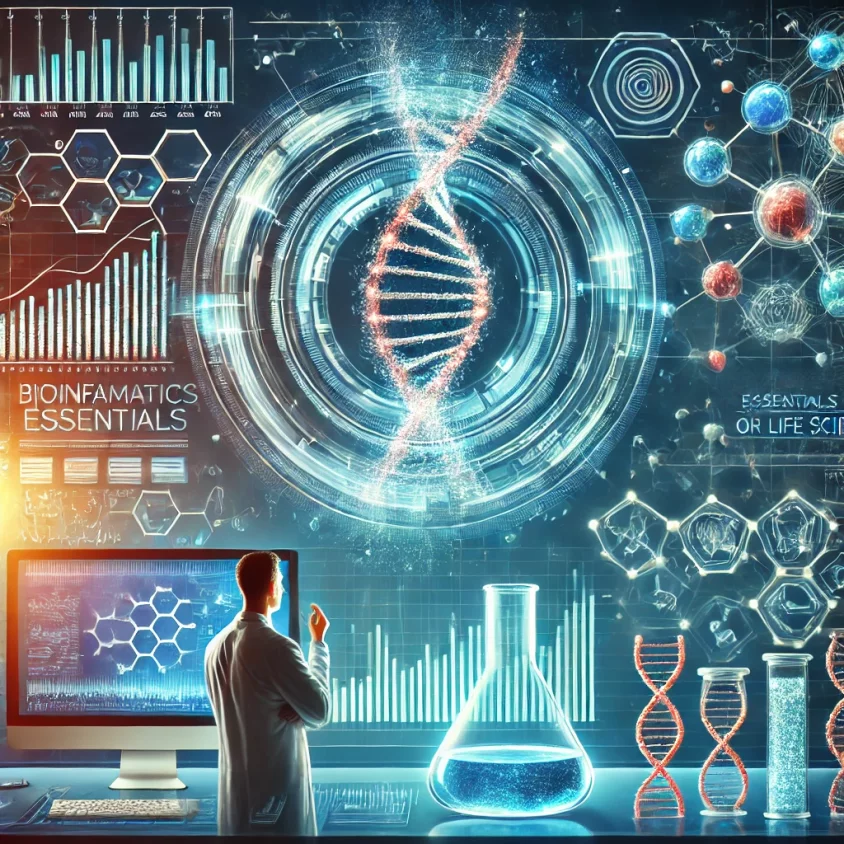Bioinformatics Essentials: Unlocking the Power of Data in Life Sciences

Introduction
The field of bioinformatics bridges biology, computer science, and data analysis to decode complex biological information. With advancements in genomics, proteomics, and transcriptomics, researchers are now able to extract meaningful insights from biological data, driving breakthroughs in medicine, agriculture, and biotechnology.
This comprehensive, self-paced online course provides all the knowledge you need to understand and apply bioinformatics principles. No external guidance is required, as every concept is fully explained, ensuring independent learning. By the end, you will confidently navigate biological databases, sequence analysis, and computational tools, allowing you to apply these skills in research or industry.
Let’s dive into the world of bioinformatics!
Course Content
1. Introduction to Bioinformatics
1.1 What is Bioinformatics?
Bioinformatics is an interdisciplinary field that combines biology, computer science, and mathematics to analyze and interpret biological data. With the exponential growth of genetic information, bioinformatics provides the essential tools to manage and analyze this data efficiently.
1.2 Importance of Bioinformatics
Bioinformatics is transforming several industries by enabling:
✅ Medical research – Identifying disease-causing mutations and developing personalized medicine.
✅ Agriculture – Improving crop genetics and resistance through genomic studies.
✅ Environmental science – Analyzing microbial genomes to monitor ecological changes.
1.3 Key Applications in Life Sciences
Genomics – Studying whole genomes to understand genetic variation.
Proteomics – Analyzing protein structures and functions.
Transcriptomics – Investigating RNA sequences to study gene expression.
Metagenomics – Exploring microbial communities in various environments.
2. Biological Macromolecules: DNA, RNA, and Proteins
2.1 The Central Dogma of Molecular Biology
Bioinformatics heavily relies on understanding how genetic information flows from DNA to RNA to proteins.
➡ DNA (Deoxyribonucleic Acid): The blueprint of life, containing genetic instructions.
➡ RNA (Ribonucleic Acid): Acts as a messenger to carry genetic instructions for protein synthesis.
➡ Proteins: Perform essential biological functions and determine an organism’s traits.
2.2 DNA and RNA Sequencing Technologies
To analyze genetic material, scientists use Next-Generation Sequencing (NGS) and Sanger Sequencing methods:
NGS: High-throughput sequencing used in genomics research.
Sanger Sequencing: A traditional method for sequencing small DNA fragments.
2.3 Protein Structure and Function
Proteins are made up of amino acids and have a specific structure:
Primary Structure – Sequence of amino acids.
Secondary Structure – Folding into α-helices and β-sheets.
Tertiary Structure – 3D shape of a single protein molecule.
Quaternary Structure – Interaction between multiple protein subunits.
3. Biological Databases and Data Retrieval
3.1 Introduction to Biological Databases
A biological database is an organized collection of biological information, such as DNA sequences, protein structures, and metabolic pathways.
Major biological databases:
NCBI (National Center for Biotechnology Information) – Houses GenBank, PubMed, and BLAST tools.
Ensembl – Genome database for vertebrates and model organisms.
UniProt – The world’s most comprehensive protein database.
KEGG (Kyoto Encyclopedia of Genes and Genomes) – Database for metabolic pathways and gene functions.
3.2 How to Access and Retrieve Data
To extract information from biological databases:
1. Visit NCBI, Ensembl, or UniProt.
2. Use gene/protein names or accession numbers to search.
3. Download sequence data in FASTA format.
4. Perform sequence analysis using computational tools.
4. Sequence Alignment and Comparative Genomics
4.1 What is Sequence Alignment?
Sequence alignment is the process of arranging DNA, RNA, or protein sequences to identify similarities and differences between them.
Types of sequence alignment:
Global alignment – Compares full sequences end-to-end (Needleman-Wunsch algorithm).
Local alignment – Identifies regions of similarity within sequences (Smith-Waterman algorithm).
4.2 Tools for Sequence Alignment
BLAST (Basic Local Alignment Search Tool) – A widely used algorithm to compare biological sequences.
Steps to use BLAST:
1. Access NCBI BLAST online.
2. Enter a DNA or protein sequence.
3. Choose the appropriate database and alignment type.
4. Run the search and analyze the results.
4.3 Multiple Sequence Alignment (MSA)
MSA compares more than two sequences simultaneously to find evolutionary relationships.
Popular MSA tools:
Clustal Omega – Fast and accurate multiple sequence alignment.
MUSCLE – Advanced method for high-accuracy alignments.
5. Next-Generation Sequencing (NGS) and Data Analysis
5.1 What is NGS?
NGS is a high-throughput sequencing technology that allows rapid sequencing of whole genomes.
5.2 Steps in NGS Data Processing
1. Quality Control – Assess sequence data quality using FastQC.
2. Trimming & Filtering – Remove low-quality reads with Trimmomatic.
3. Alignment to Reference Genome – Use BWA or Bowtie to map sequences.
4. Variant Calling – Identify mutations using GATK or SAMtools.
5. Annotation – Predict gene functions using ANNOVAR or SnpEff.
6. Structural Bioinformatics and Molecular Modeling
6.1 Introduction to Structural Bioinformatics
Structural bioinformatics focuses on predicting and analyzing 3D protein structures using computational methods.
6.2 Protein Structure Prediction Tools
PDB (Protein Data Bank) – A global repository for 3D protein structures.
Swiss-Model – An automated protein modeling tool.
AlphaFold – AI-based tool for predicting protein structures with high accuracy.
Conclusion
Bioinformatics is a game-changer in life sciences, unlocking the potential of genomic data for research and medical advancements. By mastering biological databases, sequence alignment, and computational tools, you will gain valuable skills applicable in academic research, biotechnology, and pharmaceutical industries.